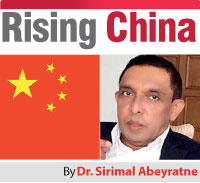Monday Apr 07, 2025
Monday Apr 07, 2025
Wednesday, 23 February 2022 00:26 - - {{hitsCtrl.values.hits}}

|
Dr. Shuwen Yan |
This article is based on the interview with Dr. Shuwen Yan – Lecturer in International Economics, Chongqing Jiaotong University, China on ‘Rising China and Lessons for Sri Lanka’. She has obtained her doctorate degree from the University of Colombo, for her research on Chinese FDI in Sri Lanka. The interview series was launched by the Veemansa Initiative – an independent think tank in the areas of economic, political and social issues. Through this interview series, Veemansa brings about the views of intellectuals and experts on various dimensions of the miraculous development experience of China, by drawing lessons, parallels and prospects for Sri Lanka.
 By the time that China adopted its open economic policies, there were no records of foreign direct investment (FDI) flows to China. In 1980 it had received about half a billion dollars FDI and it increased to over $ 2 billion by 1986 and to over $ 10 billion by 1992; after 2008, China continued to receive over $ 100 billion every year and became the largest FDI recipient in the world. As the Chinese economy grew, it also became a source country of outward direct investment (ODI) so that it became the largest FDI supplier in the world in 2020.
By the time that China adopted its open economic policies, there were no records of foreign direct investment (FDI) flows to China. In 1980 it had received about half a billion dollars FDI and it increased to over $ 2 billion by 1986 and to over $ 10 billion by 1992; after 2008, China continued to receive over $ 100 billion every year and became the largest FDI recipient in the world. As the Chinese economy grew, it also became a source country of outward direct investment (ODI) so that it became the largest FDI supplier in the world in 2020.
FDI and ODI
In terms of both inbound and outbound investment growth, China has become the number one in the world. As China has provided an attractive investment climate with clear policy direction and political stability, multinational corporations in the world have seen it as their new investment location. They can trust policies and politics of China; they have the assurance that their investment would give them best returns, while they are confident that their investment would be safe in China.
As the Chinese economy grew fast with exports, China was able to accumulate the largest stock of foreign exchange reserves in the world amounting to more than $ 3,300 million, which provided resources for the growing ODI flows as well. Chinese ODI focusses mostly in trade and transportation related investment, raw material supply for Chinese industrialisation and, market access for Chinese exports.
The Belt and Road initiative and its related policies also helps China to generate both input markets for Chinese industrialisation and output markets for Chinese exports, including the exports from infant industries. A large number of Chinese enterprises in high-tech sector have sought for international brand and technology recognition through mergers, acquisitions and joint ventures.
Chinese ODI to Sri Lanka
Because of the Chinese way of enterprise growth in the past, state-owned enterprises (SOEs) have played a key role in the Chinese ODI flows; for this reason, most of the Chinese ODI projects in the rest of the world appeared to be SOEs.
This state dominance in ODI has been changing, particularly after 2003 when the government promoted and encouraged private enterprising and their outbound investment. As a result, by 2019, the private ODI has almost reached 50% of China’s outbound investment stock value.
In the case of Sri Lanka, however, still the Chinese private investment seems to be very low. Unlike the state-owned ODI flows, the private investment requires better investment climate which has to be more competitive in the region.
Even in the case of state-owned capital flows to Sri Lanka, Chinese loans appeared to be overwhelming compared to Chinese ODI flows. This is the case of FDI flows to Sri Lanka, whether it is from China or some other countries. Generally, Sri Lanka’s annual FDI flows remain very small compared to other countries in the region so that even from China, it has been more loans than investments.
FDI flows can be classified into four categories: (a) market-seeking, (b) natural resource-seeking, (c) efficiency-seeking and, (d) strategic benefit-seeking. For Chinese ODI entering Sri Lanka, the search for access to regional market through Sri Lanka and taking advantage of the strategic location of Sri Lanka have been key factors.
While infrastructure development is important for attracting FDI, some private Chinese FDI in the manufacture sector in Katunayake has benefited from GPS+ status of the country and its FTA with India. Sri Lanka should utilise its geographical advantage and enhance its regional economic hub status. In addition, consistent policies should be maintained in order to ensure the confidence of the Chinese investors to bring further investments to the country.
FTA with China?
There have been negotiations for the China-Sri Lanka FTA for many years now, which have come to a standstill. I think an FTA between the two countries is a win-win strategy and “I am optimistic about this”. The launch of the China-Sri Lanka FTA is not just to promote the trade between the two countries. More importantly, Sri Lanka could take this opportunity to build up its regional trade and to position itself as a regional investment hub even for the Chinese domestic market.
As far as the region is concerned, Chinese ODI flows to major South Asian countries are determined by markets, resources and strategic reasons. In other words, China is not seeking the advantage of ‘cheap labour’ as China itself is a labour-abundant, populated country. However, compared to historical ODI-generating countries in the West, China is still at its ‘early stage’ of economic growth and development. In spite of that, China provides both financial and non-financial support to the rest of the world in order to facilitate ‘soft landing’ of the Chinese ODI.
China has well immersed in global production networks strengthening the value chains. Smaller economies such as Sri Lanka can also utilise the opportunities for economic collaboration with China as well as other major economies in the world in order to strengthen their integration in global value chains.
(The writer is a Professor in Economics at the University of Colombo who conducted the interview series on Rising China.)